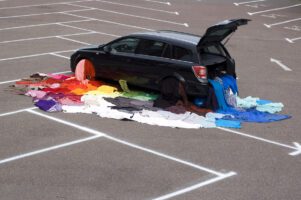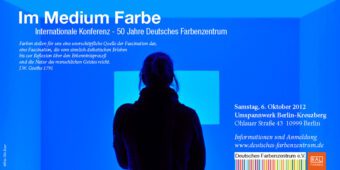[vimeo]https://vimeo.com/46566199[/vimeo]
Project authors: Carolin Raber, Felix Herbst, Christian Freitag, Paul Kirsten (students of Burg Giebichenstein, University of Art and Design Halle) under the direction of Prof. Dr. Axel Buether
Space and music
The formal structure of the sound space of music, like the visual space of architecture, can be described by contrasting relations or contrasts, such as pitch, tone strength, timbre, beat or brilliance. To describe the color space, we use media-specific scales such as brightness, hue or saturation. The proportion of overtones in the overall spectrum of a sound can be used to define its timbre, which becomes more brilliant the more of them can be heard. The lack of overtones, on the other hand, makes the sound duller.
The construction of the auditory space is a successive process in which the human being records the meaning of various auditory events one after the other and localizes them topographically. Like colors and brightness, tones and sounds already represent a meaning, since a specific frequency component must be isolated from the sound spectrum and recorded as a single event.
A person’s spatial-visual competence can be specifically promoted if we consciously deal with the “sound of spaces and images” again and again in the course of individual development. This is not only a motif that has been incorporated into the rhythmic design of many architectural buildings, but also a multi-sensory approach to the perception of urban spaces and architecture.
LightSpaceSoundParameters of the installation
The modular rhythm of the historical façade of the Thon-Dittmer-Palais determines the deconstruction process, from whose musically determined variations infinitely diverse new compositions emerge. The audience can intervene in the process on mobile displays and modify the morphoses of the architectural space using spatially effective movement parameters, which in turn follow basic musical parameters:
Musical-spatial forms:
Set the number, height and width of the surfaces – Set the depth of the extruded surfaces – Switch on the frame – Fill the frame – Color the frame filling – Set the frame width – Switch on the tail – Switch on the point display – Switch on the 3D display (experimental) – Blend the surfaces – Set the color of the surfaces – Set the opacity of the surfaces – Pause the movement – Rotate the surfaces (all 3 axes) – Set the rotation value – Set the rotation speed – Set the spatial depth of the surface planes – Set the speed of the movement – Set the rhythm of the movement, optionally with emphasis – Select the type of movement: Decay, swing, dampen – Set the acceleration of the surfaces
[download id=”28″]
Lecture “Raum Farbe Kreativität” at the Spaces conference
Link to the homepage of the University of Regensburg (organizer):


